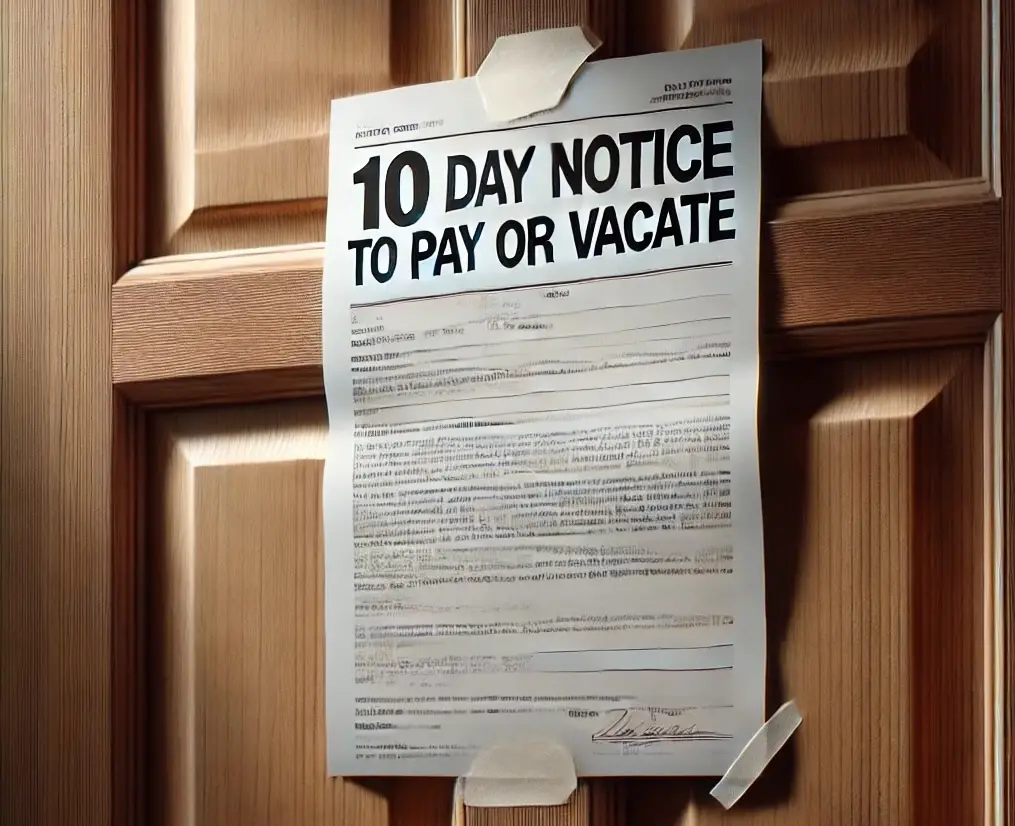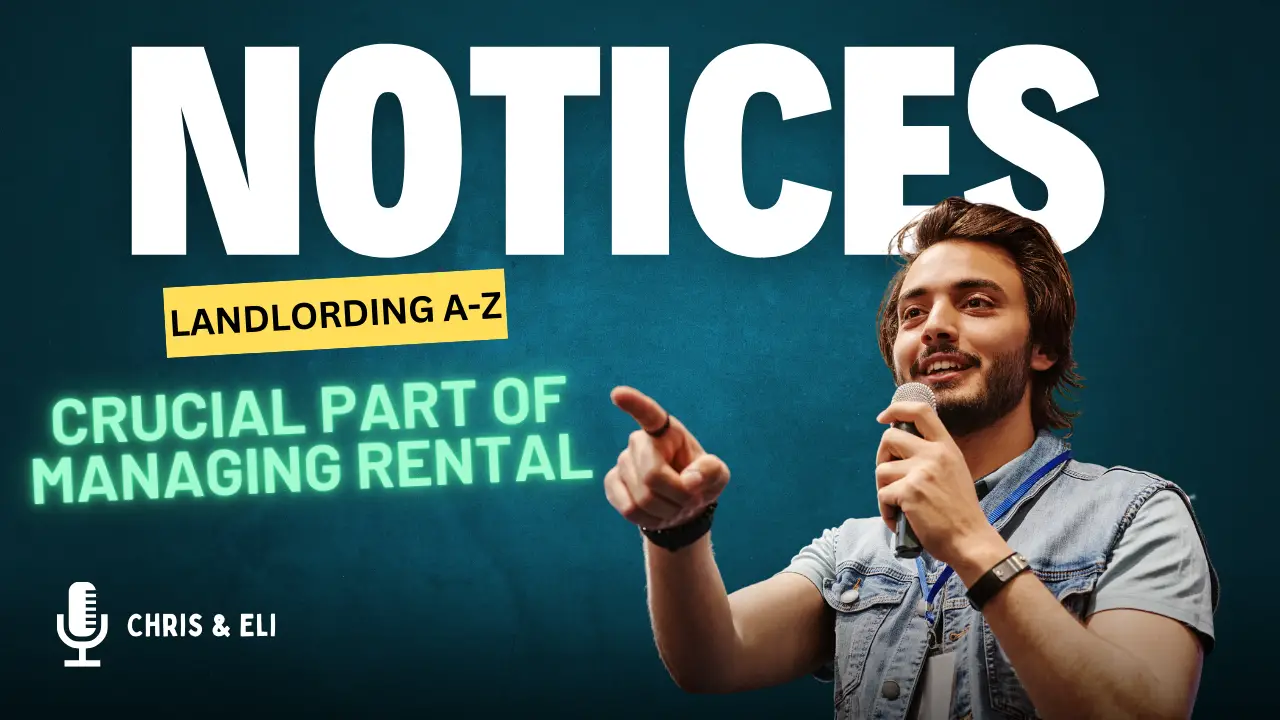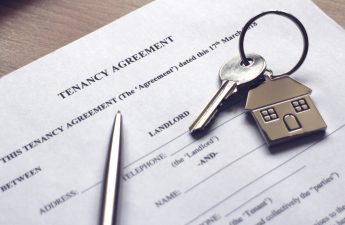While as landlords we hope to avoid issuing legal notices to tenants, it is important to understand when and how to properly undertake this process when it does become necessary. We’ll explain some of the most common types of tenant notices here, and important things to keep in mind when issuing a legal notice.
- When a tenant notice is warranted
- How notices differ from regular tenant communication
- How to serve a legal tenant notice
- Common examples of notices
For additional information, visit our YouTube channel or see the complete video.
In Practice: Pointers from our first-hand experience
When is a Tenant notice warranted?
Legal notices should be used when documentation of a lease violation or specific situation is needed, such as when a tenant must correct a lease violation within a set time frame, when a significant repair requires property access, or when notifying a tenant of changes to the lease, such as a rent increase.
Issuing a notice promptly after a lease violation—or at the first sign of trouble, especially for serious offenses—allows the resolution process to begin sooner. Early notices can also document recurring issues, and can later be used to support lease termination efforts if that becomes necessary. When unsure which notice type to use or which legal requirements to abide by, landlords should consult a legal professional to ensure they are in compliance with local landlord tenant laws.
Some situations do not require legal notice. For instance, in case of an imminent emergency, such as a fire or serious injury on the premises, a landlord or other representative may enter without notice to address the situation.
How do Tenant notices differ from regular communication?
For routine communication with tenants—such as resolving issues, scheduling check-ins, or coordinating maintenance—email or property management software messaging services are generally effective. When using email or messaging services, it’s best to request confirmation of receipt, especially when seeking tenant consent to enter the property at a specified time and date. However, certain situations require formal notice to remain compliant with local landlord-tenant laws.
Unlike emails or texts, formal notices establish a legally enforceable record of communication. Notices typically specify a time frame for tenant action or corrective measures. Legal notices must be printed, signed, and either hand-delivered or sent by certified mail. Details such as the date, time, delivery method, and recipient should be documented in a declaration of service. The rules around serving notices vary by location, so it’s important to follow the specific laws in your area.

How to serve a legal Tenant notice
When issuing a legal notice, landlords must follow local laws and regulations to ensure the notice is valid. Property owners should consult the specific legal requirements of their state and municipality, which often mandate particular language in the notice—such as informing tenants of their rights and resources. Many property management software platforms, such as Avail and TurboTenant, provide helpful templates for this purpose. The ezLandlordForms site has templates for dozens of different types of official notices, which you can tailor to meet local regulations.
Local laws also define acceptable ways to serve a notice, with some requiring personal delivery to each adult on the lease. Options range from handing the notice directly to tenants, taping it visibly to the door (must be unfolded!), delivering it by certified mail, or some combination of these methods. In some cases, regulations are precise about details like the notice’s visibility or placement. If personal delivery isn’t possible, mailing may be permitted, though it may require adding days to the notice period based on delivery timeframes. Always confirm the required method and verify how many signed copies should be provided.
Some notices demand tenant action within a specific time frame, which varies based on notice type and location. Be sure to include the correct notice period per state or municipal regulations, and know when to start counting (typically, physical delivery is “day 0,” while mailed notices may start a day or more after mailing).
After serving the notice, documentation is essential. Many jurisdictions require a “declaration of service” form, detailing when, where, and how the notice was served, along with whom it was delivered to. Keep copies of this documentation in case further action is needed. It is not necessary to provide this to the tenant you have served.

What are common examples of notices?
Because notices serve various functions, there are several distinct types, each with specific requirements for what must be included, and they are not interchangeable. Be sure to use the correct notice template for your situation. When in doubt, it’s wise to seek legal assistance to determine the appropriate notice type for your specific needs. The most common types of notices include:
Formal Notice to Enter:
Landlords must obtain tenant consent to enter the property for inspections, maintenance, or showings. This typically requires advance notice (often 48 hours) and flexible access options. If multiple reasonable times are offered, tenants cannot continually deny entry. Landlords and tenants alike are generally required to be “reasonable” about access times, not demanding or denying access at specific times without good justification.
Notice of Repairs:
When a major service disruption such as a power or water outage requires immediate repair that will impact their use of their rental, tenants should receive a repair notice. This should include information on the repair timeline, expected disruption duration, and other relevant details. A 48-hour notice is typical, but more notice should be given if possible. Significant repairs or improvements to the building is another instance where this notice would be used.
Rent increase notice (+ lease extension):
This type of notice usually coincides with the end of a lease term and jurisdictions vary in how much notice tenants must receive before a rent increase, from 30 to 60 to up to 180 days. The rent increase notice should include the change in the amount of rent due and when the change will be effective. It is common practice to pair this notice with a lease extension.
Non-renewal notice:
A non-renewal notice is used when a landlord decides not to renew a tenant’s lease. Reasons may range from tenant behavior to property needs, such as the landlord moving in or planning renovations. Landlords may be required to have a justifiable reason to issue a non-renewal notice depending on the local regulations. As with all notices, the amount of time before the lease termination date that such a notice should be served will vary, but it is commonly 60-90 days.
Transfer of Ownership or Management:
When a property is sold or management of the property changes hands, tenants must be legally notified. The notice should typically include the effective date of the change, where and how to send future rent payments, as well as who to contact with maintenance issues.
Abandonment notice:
Should a tenant vacate the property without proper notification or agreement, the landlord must issue an abandonment notice to the tenant’s last known address (often the property itself). The notice states the conditions and timeline required by law for the landlord to regain access to the property. Documentation of the process is essential, particularly if the property will be re-leased.
Disposal of Abandoned Personal Property:
After move-out, tenants may leave behind unwanted items, such as food, cleaning supplies or broken furniture, which lack real monetary value. Such items are classified as trash and can be disposed of by the landlord. However, valuable items like bicycles, jewelry, clothing, tools or intact furniture require certain procedures for disposal. A notice of abandoned personal property informs the tenant of their opportunity to reclaim these items. Local laws vary, so landlords must check for requirements about storage duration, tenant access, and disposal or sale of unclaimed items. Restrictions on what can be done with such items also depend on the reason the tenant left, with different rules applying in cases of eviction versus lease expiration.
Notice to Pay or Vacate:
If a tenant fails to make a rent or utility payment in a given month, a landlord may issue a notice to pay or vacate. The duration of compliance with the notice will depend on local regulations, but can range from 3 to 14 days. If no action is taken by the tenant to remedy the situation in this period, the landlord may have grounds to begin eviction proceedings. In such cases, it is absolutely essential to follow local landlord tenant laws and may be in your best interest to gain legal representation, such as an attorney.
Notice to Comply or Vacate:
This notice is issued when a tenant violates the conditions of the lease, including harboring unauthorized occupants, having unauthorized pets, causing clutter or unsanitary conditions, or causing noise disturbances. The notice must provide a time frame, typically around 10 days, for the tenant to address the issue before eviction proceedings may begin. As stated above, compliance with local regulations is essential, and legal guidance is recommended for issuing such notices.
Unconditional quit notice:
An unconditional quit notice is reserved for the most severe lease violations, such as illegal activities or situations posing imminent danger occurring on the property. These are situations where there is no remedy, where the tenant must go. This notice generally has a very short time frame, often 3 days, for the tenant to vacate the property. Given its seriousness, landlords often choose to involve an attorney to ensure compliance with legal requirements.
Eviction notice:
If the tenant fails to comply with previous notices (ie. when all else fails), the landlord may proceed with an eviction notice. Eviction requires a court order and adherence to the state’s termination statutes. Legal representation is strongly recommended for this process.
Takeaway
Landlords use notices as legally enforceable records of communication for specific situations, such as lease violations or major changes to lease terms. These notices may outline a time frame for tenant action, specify corrective measures, or convey legally required information. Since formal notice requirements vary by locality, it is imperative to verify the rules in your area governing notice content, delivery methods and proper documentation after serving a notice. We mentioned a few of the most common types of notices here, but there are dozens of possible types of official notices a landlord can issue.
1. Informing a tenant that something is going to happen, such as accessing to their unit or an increase in rent, and
2. Notifying a tenant that they are out of compliance with their lease agreement and documenting what they need to do to fix that, along with how long they have to remedy the problem.”

Landlording A-Z Series:
Our Landlording A-Z series will walk you through each of the stages, tasks, and issues involved in rental real estate investing. In our next installment, we’ll discuss property management software.
Disclosure: Some of the links in this post are affiliate links and Landlord Gurus may earn a commission. Our mission remains to provide valuable resources and information that helps landlords manage their rental properties efficiently and profitably. We link to these companies and their products because of their quality, not because of the commission.




